Brett Blaauw, University of Georgia; and David Shapiro-Ilan, USDA
A demanding management program is required to effectively control the intense insect and disease pests of bunch grapes in the Southeast. One such pest is the grape root borer (GRB), Vitacea polistiformis (Harris) (Lepidoptera: Sesiidae) (Figure 1). This clearwing moth attacks the roots of both wild and cultivated grapes, and as such, is a significant pest in Southeastern grape production. The life cycle of GRB is completed within 2 years, where larvae spend approximately 23 months feeding on root tissue, subsequently damaging vines by girdling the roots, thus cutting off nutrients and water to the remainder of the plant. It is estimated that a single larva feeding on the root system can reduce a vine’s yield by up to 50% (Dutcher and All, 1979). Thus, several larvae within a root system can cause substantial injury to vines through the reduction of fruit quality and eventual vine death.
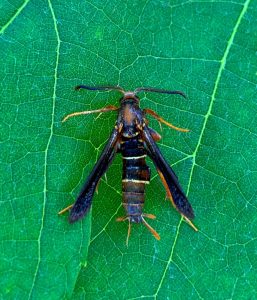
Damage caused by the grape root borer has resulted in considerable losses to the commercial grape industry. Although it often goes unnoticed until it is too late, damage due to GRB is still a key issue throughout the Southeast. Chlorpyrifos was one of the only insecticides labeled for use against grape root borer, applied as a soil drench around the base of vines as a toxic barrier to the movement of larvae to the roots. Unfortunately, chlorpyrifos is highly toxic, and as such, as of March 2022 the use of chlorpyrifos in fruit production is banned by the EPA (EPA.gov). A more environmentally friendly method for managing GRB is the use of sex pheromone-based mating disruption, which can significantly reduce vine infestation and injury due to GRB (Pfeiffer et al., 2010). While effective, the entirety of a vineyard needs to be under “disruption”, which can make mating-disruption a costly method in terms of time and money. Additionally, mating disruption works best on vineyards with flat terrain and with production area greater than 5 acres. However, many vineyards in the Southeast do not meet the ideal conditions for mating disruption and therefore, additional alternative control methods for the GRB are needed.
A well-researched area for alternative methods of management for GRB is natural enemies, specifically entomopathogenic nematodes (EPN) (for example: All et al. 1981; Jhalendra and Bergh, 2017). The nematode, Heterorhabditis bacteriophora, has been demonstrated to effectively reduced grape root borer infestations in the field and was found to be as effective as the insecticide, chlorpyrifos (Williams et al., 2002). Despite the success of H. bacteriophora in research field trials, adoption of this control tactic on a commercial scale is still virtually nonexistent, possibly due to a lack of grower education. Thus, we worked directly with bunch grape producers and extension agents in North GA to implement and evaluate novel and established EPNs for GRB management. We evaluated the EPN, Steinernema feltiae, whichwas isolated from GRB (All et al. 1981), is commercially available, and has been successfully used under harsh conditions in the Southeast for other insect pests, such as plum curculio (Conotrachelus nenuphar) in peaches (Shapiro-Ilan et al., 2011).
In order to accomplish our objectives, we established research sites at two bunch grape vineyards in Dahlonega, GA and two in Cleveland, GA. We worked directly with the cooperating farm managers at the vineyards and two local extension agents to implement and evaluate EPN use for GRB management. As such, we tested four treatments: two EPN treatments (H. bacteriophera and S. feltiae, reared at the USDA-ARS by Shapiro-Ilan), chlorpyrifos (Lorsban 4E, Dow Agrosciences), and an untreated control. The two nematode species were applied on 28 May 2021, at a rate of approximately 450 thousand nematode infectious juveniles (IJs) per vine for each respective EPN treatment and then watered with 1 liter of water per vine (Figure 2). The chlorpyrifos treatment was applied on 25 June 2021 at a rate of 23.6 ml of Lorsban 4E mixed with 1.89 l of water per vine. All treatments were applied to a circle area with a radius of approximately 0.5 m around the base of each vine. Nothing was applied to the base of the vines in the untreated control treatment plot. Adult male GRB activity was monitored throughout the study using pheromone-baited bucket traps (Great Lakes IPM; Figure 3). Disease and general insect pest management of the of the vines were left under the growers’ discretion.
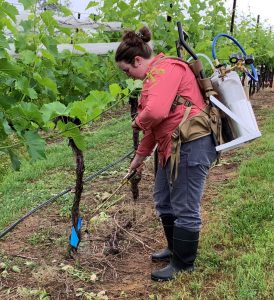
The four management treatments were evaluated by counting the number of exuviae (pupal cases) present on the soil surface within the 0.5 m radius under each of the vines in each plot on a weekly basis from 21 June to 8 September 2021 (Figure 3). The number of exuviae per date were recorded and compared amongst the treatments.
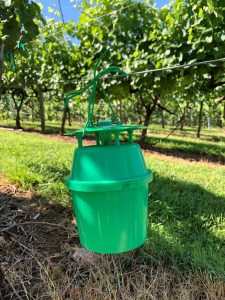
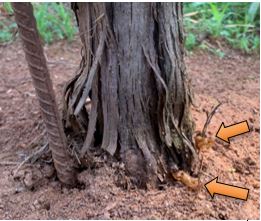
During the 2021 season, monitoring the adult GRB activity and the remnant exuviae, we determined that the moths begin flying early July and keep emerging until early September (Figure 4). Assessing the number of observed exuviae per plot, there were considerable differences among the treatments. Only the H. bacteriophera treated vines had significantly fewer exuviae than the control vines, whereas the chlorpyrifos and S. feltiae treated vines had marginally fewer exuviae than the control vines (Figure 5). These results demonstrate that EPNs, particularly H. bacteriophera, may reduce GRB infestation, potentially better than chlorpyrifos. Unfortunately, we were unable to recover any EPNs from the soil when evaluating nematode persistence, so neither of the EPN species appear to last more than a couple of months in the soil. As such, it is likely that the nematodes will need to be applied on an annual basis. Since conventional insecticides and mating disruption are both only preventative management strategies for GRB, nematodes have the potential to be both preventative and curative, which makes this tactic even more encouraging. Additional years of research are warranted, especially since GRB has a two-year life cycle, so additional affects may be uncovered in subsequent years.
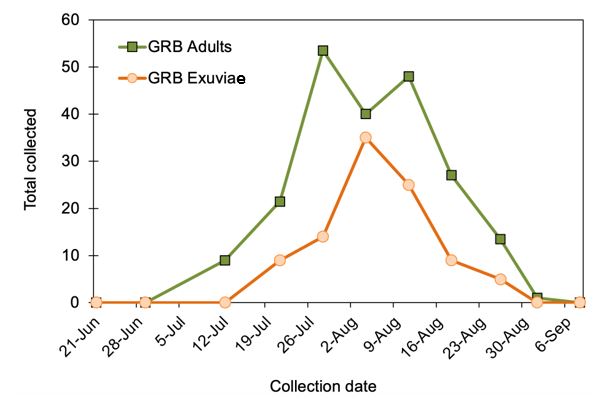
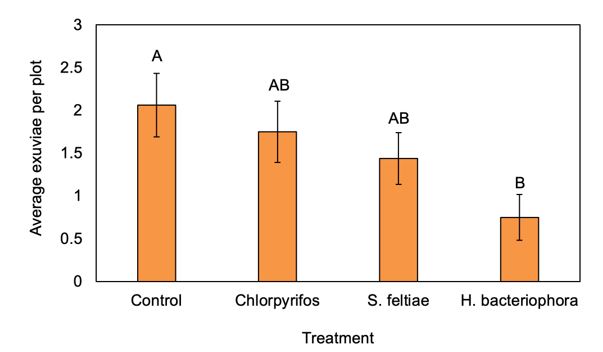
References cited:
All, J. N., Saunders, M. C., Dutcher, J. D., and Javid, A. M. 1981. Susceptibility of grape root borer larvae, Vitacea polistiformis (Lepidoptera: Sesiidae) to Neoaplectana carpocapsae (Nematoda: Rhabditida): potential of host kairomones for enhancement of nematode activity in grape vineyards. Miscellaneous Publication of Entomological Society of America. 12:9–14.
Dutcher, J. D. and All, J. N. 1979. Damage impact of larval feeding by the grape root borer in a commercial Concord grape vineyard. Journal of Economic Entomology. 72:159-161.
Jhalendra, P. R. and Bergh, J. C. 2017. Grape root borer (Lepidoptera: Sesiidae): An economic pest of commercial vineyards in the Eastern United States. Journal of Integrated Pest Management. 8:30;1-7.
Pfeiffer, D. G., Luab, C. A., Jordan, T. A., Wallingford, A. K., and Cassell, M. 2010. Control of grape root borer using mating disruption–2009, pp. 35–36. In Proceedings, 85th Cumberland-Shenandoah Fruit Workers Conference, 19–20 November 2009, Winchester, VA.
Shapiro-Ilan, D. I., Leskey, T. C., Wright, S. E. 2011. Virulence of entomopathogenic nematodes to plum curculio, Conotrachelus nenuphar: Effects of strain, temperature, and soil type. Journal of Nematology. 43:187-195.
Williams, R. N., Fickle, D. S., Grewal, P. S., and Meyer, J. R. 2002. Assessing the potential of entomopathogenic nematodes to control the grape root borer, Vitacea polistiformis (Lepidoptera: Sesiidae) through laboratory and greenhouse bioassays. Biocontrol Science and Technology. 12:35–42.